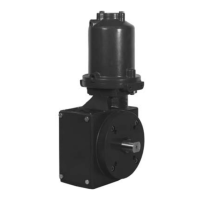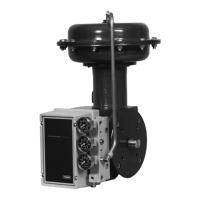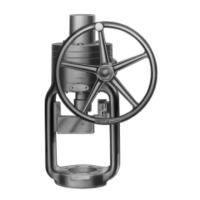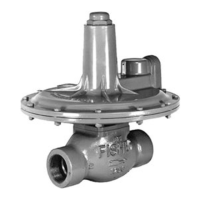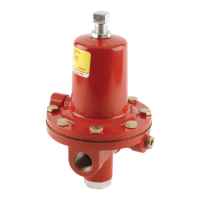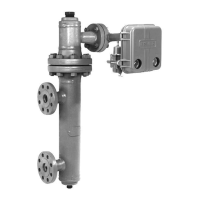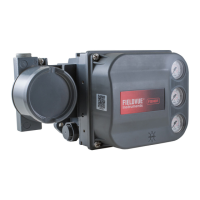Types 1098-EGR and 1098H-EGR
6
actuator and main valve body, while the pilot control
spring range is displayed on the pilot spring case, and
the pilot restriction code is stamped on the pilot body
(S = standard gain, L = low gain, and H = high gain).
Principle of Operation
The pilot-operated Types 1098-EGR and 1098H-EGR
regulators both use inlet pressure as the operating
medium, which is reduced through pilot operation to load
the actuator diaphragm. Outlet or downstream pressure
opposes loading pressure in the actuator and also
opposes the pilot control spring. The Type 1098-EGR
regulator operation schematic is shown in Figure 2.
In operation, assume that outlet pressure is below
the pilot control setting. Control spring force on
the pilot diaphragm thus opens the pilot valve plug
providing additional loading pressure to the actuator
diaphragm. This loading pressure forces the actuator
stem forward, opening the main valve plug via a bump
connection. The upward motion of the plug allows gas
to ow through the cage into the downstream system.
When downstream demand has been satised, outlet
pressure tends to increase, acting on the pilot and
actuator diaphragms. This pressure exceeds the pilot
control spring setting, moving the pilot diaphragm away
and letting the valve plug spring (Type 6351, 61 Series, or
Y600AM pilots) or bellows (Types 6352 through
6354M pilots) close the pilot valve plug (unbalanced in the
Type 6351 or 61 Series pilots but balanced in the
Types 6352 through 6354M pilot). Excess loading
pressure on the actuator diaphragm escapes downstream
through the bleed hole (Type 6351 pilot), bleed orice
(61 Series pilot), restriction (Types 6352 through
6354M pilots) or xed restrictor (Type Y600AM pilot).
Reduced actuator loading pressure permits the main
valve to close. The combination of main valve spring
force and valve plug unbalance provides positive valve
plug shutoff against the port and upper seals.
To protect the Type 1098 or 1098H actuator diaphragm
from excessive differential pressure, the 6300 Series
pilots have a relief valve that allows loading pressure to
bleed downstream at approximately 25 psig (1,7 bar)
differential across the actuator diaphragm. An external
relief valve (Type 1806) is required when differential is
higher than 25 psid (1,7 bar d) or when using the
61 or Y600A Series pilots.
40 PSI (2,8 bar) Relief Valve
A mounting assembly for a 40 psi (2,8 bar) differential
relief valve is available for the Type 1098-EGR. The
standard 25 psi (1,7 bar) differential relief valve
construction is integrally mounted between the loading
and downstream pressures in the 6351 through
6354 Series regulating pilots. Both differential relief
valves protect the main regulator diaphragm from
damage that may occur from too high differential
between the loading pressure and downstream pressure.
The 40 psi (2,8 bar) differential relief valve construction
is designed specically for the red main valve spring
selection in the 6-inch (DN 150) Type 1098-EGR-6354
with the size 30 actuator. This construction uses the
Type 1806H relief valve (with a setting of 40 psi
(2,8 bar)) to relieve excess loading pressure and does not
interfere with the normal operation of the regulator.
Installation and Startup
!
WARNING
Personal injury, equipment damage, or
leakage due to escaping accumulated
gas or bursting of pressure-containing
parts may result if this regulator is
overpressured or is installed where
service conditions could exceed the limits
on the appropriate nameplate, or where
conditions exceed any ratings of the
adjacent piping or piping connections.
To avoid such injury or damage, provide
pressure-relieving or pressure-limiting
devices to prevent service conditions from
exceeding those limits.
Additionally, physical damage to the
regulator may result in personal injury
and property damage due to escaping
accumulated gas. To avoid such injury
and damage, install the regulator in a
safe location.
Standard Single-Pilot Regulator
(Figure 3)
Installations
A Type 1098-EGR or 1098H-EGR regulator bleeds
no gas to the atmosphere, making it suitable for
installation in pits or other enclosed locations without
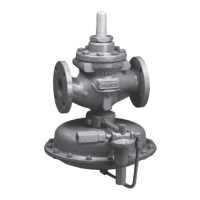
